(The Irish nation and people are such an integral part of the tapestry of humanity that neither can be adequately covered by a single article, so we’ll start with the the generic elements of interest to folks considering a visit to Ireland, and additional installments will expand on topics historical, cultural, and political.)
A bit of theme music to kick this off:
O’Reillys & the Paddy Hats (Good Irish rock. No U2 doesn’t count. Ireland has officially disowned Bono for being a jerk.)
Enya: (Yes, she’s Irish)
Clannad: (Enya’s siblings and relatives)
Flights
Aer Lingus was the airline of choice on this expedition. In spite of the sexy sounding name, and the generally positive online rep, this was like flying Southwest back in the 70’s and 80’s. (Get ‘em on. Get em’ out. Discount all the way.) The outbound food was hot, but that was about all it had going for it. Their popsicle stick (literally wooden) cutlery was a laughable virtue signal to the Greens, but it worked OK for the intended purpose. I say laughable because everything went into the same trash bin, so some poor bastard in Bangladesh has to dig through the trash to “recycle” it. The upside of our return flight was we went through US Customs in Dublin, so we did not have to go through that process in Chicago.
(WARNING: Do NOT book a connection through Chicago when returning to the USA! You arrive at Terminal 5 (International), and have to change terminals via their rail system. Normally this would not be a big deal in a civilized territory, but the rail system is OUTSIDE of the security environment which forced travelers to go back through TSA screening to get to their connection.
The attitude of the TSA officers, was the rudest I have encountered since the Patriot act created the agency. A mother traveling alone with two children under five, and an infant in a chest carrier, leaned forward to do something I could not see, and the infant fell out of the carrier to the concrete floor. When the mother lifted the child, the baby was unconscious. The TSA agents just sat there doing nothing as the mother begged for help. People in the line started hollering for a doctor, and a woman who was in line to check in for her own flight ran down to assist. The TSA people tried to stop her from crossing into the pre-check area to assist the child, but otherwise did nothing. The infuriating part of this was the officers were not reacting like this was some kind of potential distraction to cover the beginning of a terrorist event. They just didn’t FNG care.
If you have no choice but to go through Chicago, make sure you have a 5-hour layover. These days your arrival will probably be late, and if you get hung up in TSA making your connection, you better have a hotel on speed dial.)
Expedition Thumbnail
The Traveler’s plan was for two days in Dublin followed by a three-day small bus tour to the Galway region, two big bus day trips, and wrapping with two more days in Dublin. The weather throughout was bright and sunny with temps up to about 26C/80F. Mornings and evenings were 15C/60F. The lack of rain surprised us, but you cannot count on getting lucky, so pack the rain gear.
Eats
Unless you try an ethnic restaurant, expect pub food pretty much everywhere. Almost every place we stopped had the same four or five food groups on the menu:
Irish Stew – Beef stew with potatoes, carrots, etc.
Guinness Beef Pie – Beef bits, carrots, peas, and a Guinness flavored sauce over a bed of mashed potatoes, and topped with a pie crust.
Angus Beef Burger and chips (fries)
Fish and Chips
Bangers & Mash – Fried pork sausage served on a bed of mashed potatoes.
A few vegetarian offerings were available along with Buffalo Wings, and other oddments adopted from American pub food. If you need a high fiber diet to survive, plan to eat a lot of oatmeal at breakfast.
See one pub, and you’ve seen ‘em all was the reality we faced, but all was not lost.
In the interest of the experience, we started with a pub called the Hairy Lemon in Dublin. It is often difficult to separate a place the locals go from a tourist trap. Hairy Lemon was around the corner from the Molly Malone statue, and definitely tourist focused.
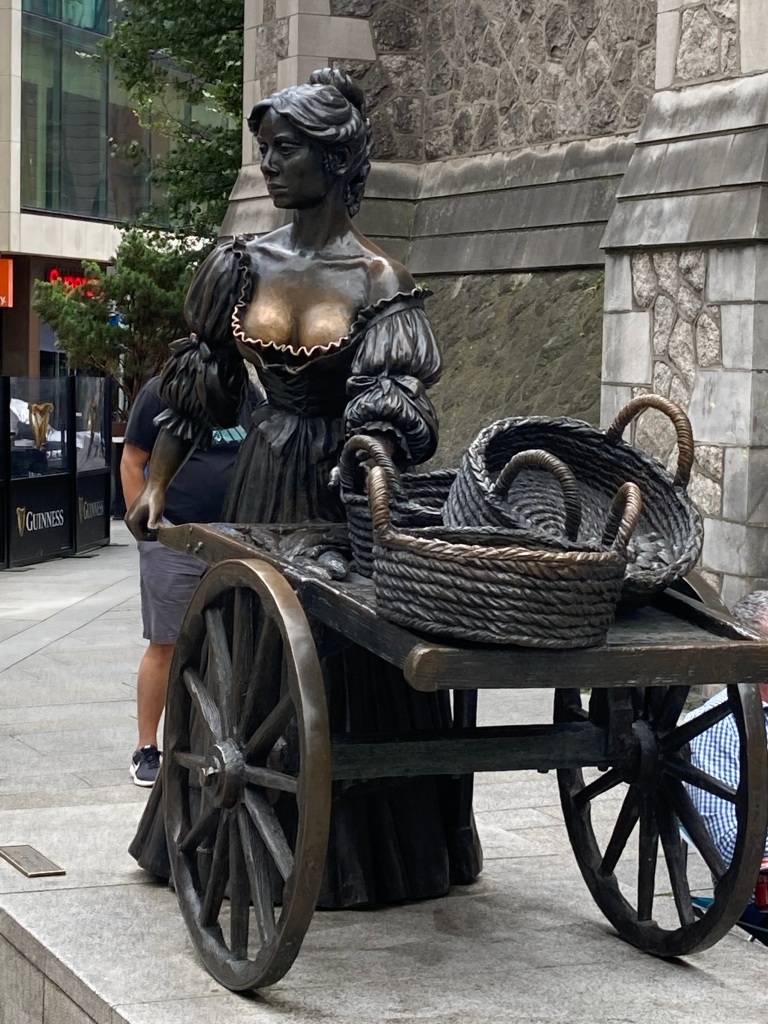
A young lass was practicing her concertina next to Molly under the watchful eye of her father when we went by.
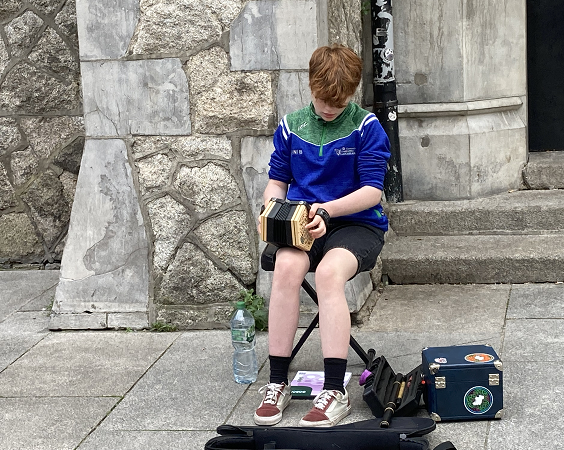
I paused to ask the gent how the Irish felt about struggling for independence for 700 years only to be sold down the river to Brussels (aka the EU). He hedged his answer before suggesting I look for a pub called The Long Hall where open debate is live and well. Unfortunately, time constraints prevented an evening at this establishment, but it is on the list for the next visit.
The orange façade of a Spanish tappas restaurant called Salamanca invited us in one evening. This place is in direct view of Molly Malone, and well worth a visit even if you live for pub food. The ladies took a shine to their strawberry-basil sangria, and in spite of being a hardcode whiskey drinker, I have to admit it was tasty.
Another non-Pub adventure was the Italian place Toscana. The ladies enjoyed pasta while I took on a twelve-inch Prosciutto di Parma pizza. After a sample from the Mrs’ plate, I should have gone for the Lasagna, but all enjoyed the meal.
Hotels
Our home base was the Maldron Hotel on Kevin Street in Dublin. The room was adequate, and we had a nice view of the steeple of St. Patrick’s Cathedral above the row houses opposite from the hotel. The restaurant served an “Irish Breakfast” that is hardly distinguishable from a “Scottish Breakfast”, or an “English Breakfast” consisting of Bacon (steamed ham), Eggs (scrambled or over-easy), Hash browns, Black or White pudding, Bangers (grilled sausage), Baked Beans, and various baked goods. In this case, the black pudding had a touch of haggis flavoring, that brought back fond memories of Edinburgh
Always book a hotel with breakfast. It just saves time and misery when you wake up fighting jet lag, hangover, and other miseries. The Maldron offers take-away breakfasts if you order the day before. It was a turkey and cheese sandwich, a piece of fruit, and cup of yogurt, but far better than an empty stomach when you are catching an early tour bus.
Dinner offerings, were the universal pub food, with a pasta and veggie stir-fry options tacked on. Portions and prices were fair, and the food quality comparable to the USA (if that’s saying anything). The USD was trading at $0.90 to the Euro. Meals ran €15.00 – €20.00 a plate.
The bar service at the Maldron was pathetic. They offered a generous bar menu, but almost everything you ordered was “not available”. This includes Jameson Whiskey! Do your drinking elsewhere, and stagger back to the hotel to sleep.
Overall the Maldron gets high marks for being centrally located, clean, and up to date. We stayed there before and after the Galway trip, and would gladly stay there again.
We spent two nights in the Flannery Hotel in Galway. This hotel is adequate, but has not been updated recently. There are no USB charger ports in the room, so you must have a plug adapter suitable for Irish/EU power sockets.

We had a lovely view of a Rugby field behind the hotel, but we were not there for the view. The restaurant offered the standard “Breakfast” options. The dinner menu was about the same as elsewhere, but the portions were fair, and quality was adequate. Flannery’s bar service was quite professional.
Things to Do/See In Dublin
(This section will be a listing of the sights and tours we took in. Some will be links to supporting articles offering an expanded description of the historical, social, and political aspects of the events. This section will be updated as the supporting material is added.)
Hop on-Hop off Tour Buses: These have become a staple Day 1 activity of our vacations. You buy 24-hour or 48-hour tickets, and you can catch any of the company’s buses that circulate through the city. The tours come with a recorded audio commentary describing the sights along the route, but the real benefit of these tours is a quick way to orient yourself in relation to a city’s landmarks. Tourist maps provided by hotels and visitor bureaus are usually crap, so building a mental model of the city is critical to navigation. Take the full ride around the city. Make notes on interesting things along the way. Once the tour starts over, you can jump off at those spots, and then grab the next bus that comes along. You have unlimited uses of the buses while your ticket is in effect, so leverage this. In Dublin we used Big Bus Tours. Unlike other companies, the Big Bus drivers provided the English commentary along the route. We rode with three different drivers. Our favorite driver was Jerry. We loved his enthusiastic presentation style, and his expansive knowledge of Irish history that he used to flesh out the standard tour script as we moved between points of interest. (Note: Do not confuse this reference to the company “Big Bus Tours” with the description of a big bus tour below.)
St. Patrick’s Cathedral & Christ Church: Originally Catholic cathedrals, these two churches were forcibly converted to Anglican (Church of England) under Henry VIII.
We visited St. Patrick’s because it was St. Patrick’s, of course. You get an audio tour player with the price of admission, but the noise level inside the building made it almost useless. The explanatory signage made up for this. If you stop by St. Pat’s say “Hi” to Jonathan Swift.
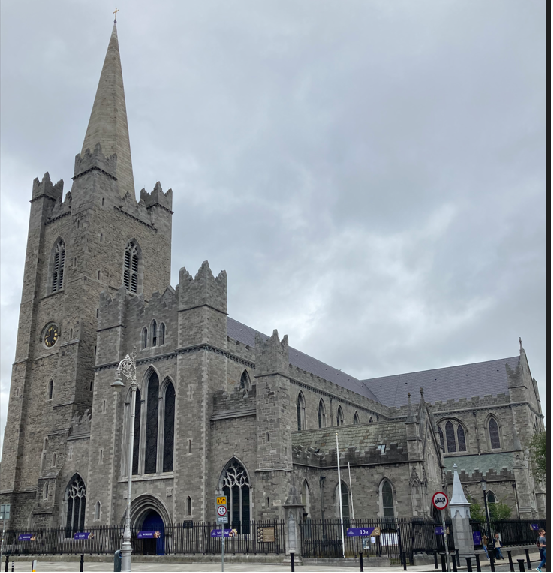

Christ Church covers a few city blocks, so it is hard to miss as a landmark. We skipped this Cathedral except for the section given over to the “Dublinia” exhibit described below. The best part of Christ Church and St. Patrick’s is the steeples are in sight of each other making fantastic landmarks for getting around. Originally, Christ Church was inside Dublin’s city walls, and St. Patrick’s was outside, but the walls are long gone except in Belfast, but more on that later..

Dublinia: Dublin takes its name from the junction of the Liffey and Poddle rivers . This junction stirred up the silt creating a dark pool called “Dubh Linn” (Duv-lin) or “Dark Pool” by the locals. Dublin also has the distinction of being a rather large Viking settlement, and the Dublinia museum examines the Scandinavian influence on the evolution of the Dublin region. Well worth your time to take in.

Dublin Castle: Not really a castle anymore, Dublin Castle is the seat of government for Ireland. The tour covers some of the original foundations of the castle as well as the State apartments used for official events. One display is a huge banquet table covered in glass potatoes presented by Queen Elizabeth II on her visit to Ireland in commemoration of the Irish potato famine in the 1840s that cause so many Irish to flee their country in hopes of survival. If ever a head of state delivered a monument to tastelessness, this one is close to the top. The originator of this idea should have been flogged.


Jeanie Johnston: Built by a Scotsman, and named for a character in a Rabbie Burns poem, the Jeanie Johnston was one of the many “coffin ships” desperate families used to flee the famine of the 1840’s. The ship permanently anchored on the Liffey river is a replica of the original Jeanie Johnston. Admission includes a guided tour of the ship. Steve was our guide, and his masterful presentation of the story of this ship will almost bring you to tears. Of all the coffin ships that took desperate people abroad, the Jeanie Johnston is the only one never to have lost a soul. Even after she sank…Ask Steve about it.

Famine Memorial: Just down the way from the Jeanie Johnston is a group of haunting figures shuffling toward the unknown. This memorial to those who suffered through the famine will remind you of photos of concentration camp survivors the world over. The famine was yet another case of ethnic cleansing fully deserving of remembrance.

National Museum of Ireland: If “National” appears in the name of a museum in Ireland, it means admission is free. We only had time to take in the Archaeology section, and it was well worth it. We especially enjoyed seeing the Viking Gold and nobody can help but be fascinated by the “Boggies”. These are naturally occurring mummies believed to have been created by placing the victims of ritual sacrifice into peat bogs. The chemical composition of the bog prevents decay, and the person is transformed into a mummy often with hair, skin, and clothing almost intact.

Trinity College & Book of Kells: The Book of Kells is a mediaeval illuminated manuscript containing the first four gospels of the New Testament. The museum consists of wall panels and some small display cases explaining the history of illuminated manuscripts, how the paints were manufactured, and photos of the Book of Kells specifically.

One of the cooler things at Trinity College is the Old Library and the “Long Room” containing upwards of 200,000 books from the 1500’s on up. Beautiful vaulted ceilings and dark wood paneling made this like something out of Hogwarts.
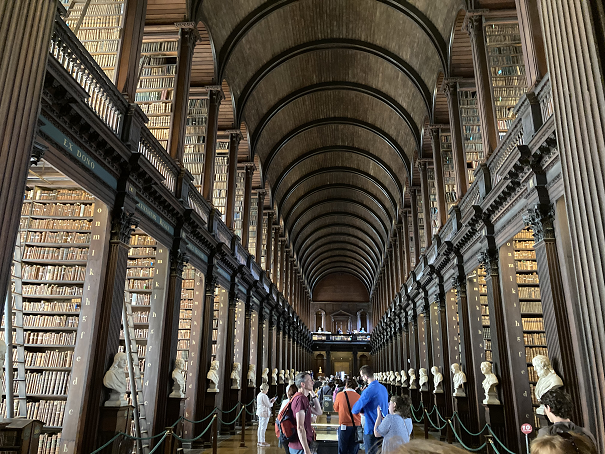
WARNING: This is not an impulse stop to fill in a dead spot between other sights. You must book your tickets online and in advance. Demand is high, so plan accordingly. Considering the price and difficulty getting tickets on impulse, either plan for this stop up front, or give it a miss.
Kilmainham Gaol: (pronounced Kil-mane-ham jail) This is the place where Irish heroes were jailed and executed for their participation in the Easter Uprising in 1916. This museum requires advanced ticket purchase, and book early to get a spot. The jail was almost lost to neglect until a foundation began restoration and preservation. The tours are very well presented, and the museum is well worth the time.

Note: The Netflix series “Rebellion” gives a decent thumbnail of the Easter Uprising, and provides a point of reference for several sites in and around Dublin like the General Post Office that were occupied by the resistance fighters. Many of these sites are mentioned in the Hop-on/Hop-off bus tour, but a little background on the Uprising helps put the bits together
On the Road
We took three bus tours around Ireland, and I’ll describe them in order.
First I must explain the difference between “Small Bus” and “Big Bus” tours. A big bus expedition drags 45-60 strangers across the countryside. If you are lucky, a tour guide is on the bus providing a running commentary on the sights, and answering questions while the driver drives. On a small bus tour, you have about fifteen passengers, and the driver fulfills both driver and tour guide roles. With the smaller vehicle the setting is much more intimate. Everyone can hear what is said, and participate in the conversation. A small bus is a physically smaller vehicle meaning the tour company can offer more off the beaten path stops along the way. Big bus tours seem very rushed at the stops because it takes so long for that many people to exit the bus and to get back on the bus at departure time. The difference between a “big bus” tour and a “small bus” tour must be experienced to be appreciated.
3-day trip to Galway with Rabbie’s Tours: We first met Rabbie’s on our jaunt through Scotland. They are a “small bus” company. Rabbie’s company motto should be “We’re goin’! Come join the fun!” because unlike the big bus companies, their minimum number of passengers is 1. They guarantee your tour where other companies may cancel on your if they fail to hit their minimum head count.
Our driver was a fine gent named Andy, who was a font of good humor and information on Ireland’s politics, history, and cuisine. We had five people on the bus, and a good time was had by all.
The trip description from Rabbie’s website with editorial comments inserted.:
Corcomroe Abbey A ruined abbey. Oddly enough, the cemtary is still in use with a number of fresh interments.

The Burren – This national park is home to some of Ireland’s most profound spiritual and natural culture.
<Traveler> The Burren has a chamber burial marked by standing stones dating back to the Neolithic. Wear good hiking shoes, the rocks can be murder on weak ankles. </Traveler>

The Cliffs of Moher – An awe-inspiring 700ft drop into the crashing waves of the Atlantic Ocean.

Galway City – After the sights of Galway Bay, this lively place will be your home. Plenty of excellent food and cosy pubs to choose from.
<Traveler> Galway only seems to have a tiny center section composed of about five blocks of shops and pubs downtown. Andy warned us to “GO EARLY” if we wanted to get a table. He should have said “Go VERY early”. He recommended The King’s Head <https://www.thekingshead.ie/food> and The Dail < https://thedailbar.com/ > (pronounced like the name “Doyle”), and McDonough’s < http://www.mcdonaghs.net/>. The only space we could find space for three was a tiny donut of a table wrapped around a pillar next to the bar in The Dail. Our three stools posed a significant traffic hazard to the bachelor party taking place at the neighboring table, and the waitresses coming and going form the bar. The food was typical, and uninspiring. The canned pop music too loud to allow conversation. Definitely not the experience we were looking for.
Galway’s center offered a variety of street musicians and performers of varying style and quality. One gent from the southlands was skillfully ripping up his sitar < https://www.britannica.com/art/sitar > on one corner, while a couple of girls in sequined skirts were clicking their heels just around the next bend.</Traveler>
Kylemore Abbey – A home for Benedictine nuns fleeing World War 1, this incredible neo-gothic building is steeped in the scars and bravery of world history.
<Traveler> Hold your heartstrings ladies. This is a hunting lodge, remodeled into a Disney-class castle built by a man for the love of his life. The gardens are amazing. Well worth the time. </Traveler>
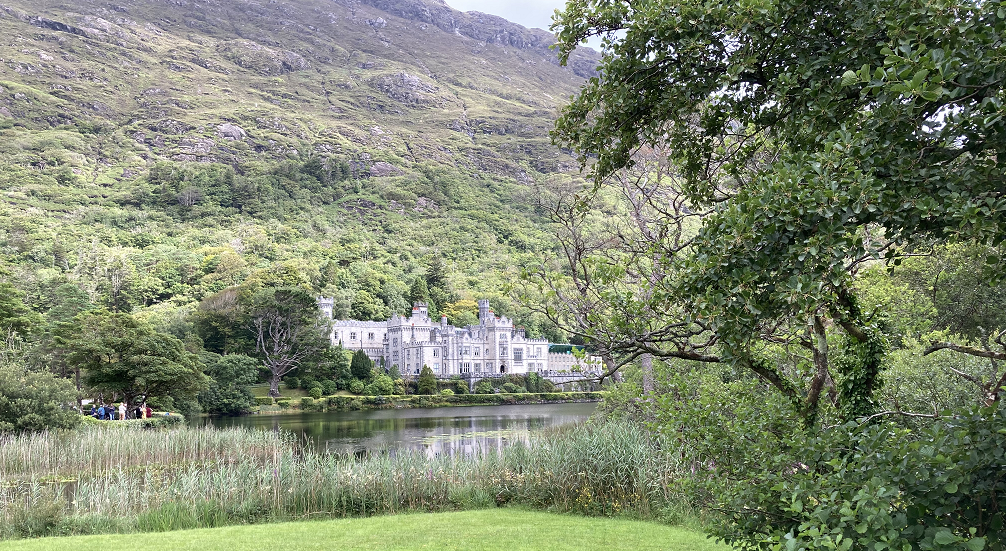
Connemara National Park – Stunning vistas and superb wildlife abound within this famously serene park, from the towering peaks of the Twelve Bens to the panoramic Sky Road.

Clonmacnoise – (Pronounced like its spelled Clon-Mac-Noise) A 1500 year old abbey, whose ancient spirituality pervades the whole area. The heart of Ireland’s Golden Age of Learning.

Kilbeggan Distillery – The oldest licensed distillery on Earth has something for the history buff and the beverage connoisseur. < https://www.kilbegganwhiskey.com/the-distillery/ >
<Traveler> The whiskey we sampled was not to my taste, but the tour was very interesting, especially because the place is run by a steam engine, but only when the river is too low to drive the waterwheel. A worthy stop for those with a bit of Steampunk in their veins. </Traveler>

Another benefit of the small bus tours is flexibility. We were making such good time on our itinerary, we were able to make an unscheduled pitstop in the village of Cong. Yes, its pronounced just like “Kong” of the film King Kong, but in this case, it is famous for another film, The Quiet Man starring John Wayne and Maureen O’Hara. Personally, I think the statue captures The Duke pretty well, but Maureen lost out.

Day Trip to Blarney Castle with Irish Day Tours: This was a big bus tour with our driver David. The bus was FULL making loading and exiting take longer than the time allowed to take in the sights you stopped for.
9:00 AM: ROCK OF CASHEL
We will arrive at one of Ireland’s 7 wonders – The Rock of Cashel! Here we will explore the Hall of Vicars, Cormack’s Chapel, Celtic Cathedral, Round Tower, and the surrounding grounds filled with ancient high crosses! In addition, you will have the marvelous opportunity to gaze upon one of Ireland’s oldest Romanesque wall paintings inside the world-famous historical landmark.

11:30 AM: KISS THE STONE AT BLARNEY CASTLE
We then arrive at Blarney Castle, which is the highlight of the tour for most. Blarney Castle is known around the world for its famous Blarney Stone. Kiss the stone and receive the “gift of the gab”. Blarney Castle isn’t all about the Stone; the Blarney castle itself is worthy of exploration as are its fantastic lush grounds and woodland walks. There is much to see and explore. See the Rock Close and find the Wishing Steps to make a wish!
<Traveler> Blarney Castle is well preserved, and the grounds are lovely. The infamous Blarney Stone is at the top of the battlements (aka on the roof). To reach the top of the battlements, you must climb VERY narrow, VERY steep, and VERY uneven spiral stair cases. If you are over 6ft (183cm) tall, you will have problems not knocking yourself out moving inside the castle. If your waist size prevents you from flying coach comfortably, you will have problems with the stairs. Good footwear is a must. This is not meant to be offensive. This is fair warning, and a safety issue. A fall on the staircase endangers not only the person who falls, but all of the people beneath them. I say “beneath” because even with proper social distancing, the staircase is so steep your nose will be mere inches from the backside of the person ahead of you. A dropped cellphone will not stop bouncing until it hits the basement, and neither will a human being. </Traveler>



15:30 PM: CAHIR CASTLE
For our last stop of the day, we will arrive at Cahir Castle in County Tipperary. Cahir Castle is one of Ireland’s most preserved castles still boasting a lot of its original structure. Originally built as a defensive castle it is situated on a rocky island on the River Suir. Enjoy a presentation on the history of the castle to begin your experience exploring the beautiful Cahir Castle.
<Traveler> This was a Anglo-Norman castle, and is extremely well maintained. It sports two canon balls embedded in the walls from a siege. Our tour guide was great. She had a perky enthusiasm for descibing the horrors of siege warfare and the gruesome results. Well worth the time. </Traveler>

Day Trip to the Giant’s Causeway and Belfast with Paddy Wagon Tours:
Another full big bus trip with our driver, Brian providing the commentary, and a bit of song along the way. The rest of the trip was a COMPLETE RIP-OFF. Read on for details.
CARRICK A REDE (photos)
Enjoy amazing views to and from the rope bridge. Traditionally fishermen erected the bridge to Carrick-a-Rede Island over a chasm 23m deep and 20m wide, to harvest salmon from their nets. With views of the Mull of Kintyre in Scotland and Rathlin Island.
<Traveler> This was a tease. We found out once we were on the bus, that the park has been closed to big bus tours, so we got a scenic overlook photo op instead. Not a huge loss, but it shows a lack of care on the part of Paddy Wagon that they fail to keep their tour descriptions current. </Traveler>
GIANT’S CAUSEWAY (at least 90 minutes)
We continue along the coastal drive with fantastic views of Whitepark Bay and Portbradden. We visit the 37,000 basalt columns whose tops form “stepping stones” leading from the cliff foot and disappearing under the sea. They reappear in the island of Straffe, hence the legend that this was a road built by the giant Finn McCool to enable him to cross over to Scotland. Truly an amazing wonder of the world!

<Traveler> This was amazing. Photos can’t do this rock formation justice. It is not that the formation is so massive, but the bizarre shapes of the stones themselves. The other amazing thing is how far the visitor center is from the formation itself. The walk to the Causeway is down a rather long slope. The route is paved, but would be a rough climb back up in the rain. Fortunately, a shuttlebus runs between the visitor center and the Causeway every few minutes, so folks with mobility issues can enjoy this site comfortably. Again, shoes with solid ankle support and clingy soles are a must. I wore sneakers, and even in dry weather, the rocks were slick enough to cause concern. Surviving a fall on the causeway means a nice helicopter ride to the local medics. </Traveler>
DARK HEDGES
One of the most popular natural phenomena in Northern Ireland, the Dark Hedges were used as a set for the hit TV series Game of Thrones. It was the famous King’s Road in Season 2. The hedges were planted by the Stuart family in the eighteenth century. It was intended to impress visitors as they approached the entrance to their home, Gracehill House. Two centuries later, the trees remain a magnificent sight and have become known as the Dark Hedges.

<Traveler>This was just a sad attempt to create a tourist trap for Game of Thrones (GoT) fans. The stop is adjacent to an abandoned GoT themed hotel several investors have tried to get off the ground. Other than walking down the road between the rows of trees, and smelling the livestock, there is a small café waiting to take your money. Definitely a thing to miss. </Traveler>
BALLINTOY
Small picturesque village, Ballintoy was an ideal location for several Game of Thrones sets. You will recognize the landscapes from season 2 that were used in some of the most crucial scenes in the series.
<Traveler> Another sad attempt to squeeze tourism out of GoT. It’s a pretty photo op, but so memorable, I had to go back and google it to recall what it was. </Traveler>
COASTLINE VIEWS
We travel along the Causeway Coastal route between Ballycastle and Dunluce to experience one of the most dramatic drives in the world, now rated as one of the world’s great road journeys. We transport you by windswept cliffs, spectacular scenery, and fabulous unspoiled beaches.
<Traveler> I agree, the coastal scenery is lovely, but it was not exactly what I paid for on this ride. We stopped for lunch at a “cafe” that we suspect was a collaboration among the bus tour companies. The food is served cafeteria style. The portions seemed fair, but the manner it reminded us of a trip to Greece where the tour guide was obviously steering the guests to specific restaurants along the stops. This place was out in the boonies, so we had zero options, but after Greece, we took no chances. Beware of this trick. I don’t mind the guides suggesting places to eat, but I resent them not being up front about the financial relationship guiding their recommendations. </Traveler>
DUNLUCE CASTLE
We continue a wonderful day with a photo stop at Dunluce Castle, home to the McDonnell Clan for many years and considered the most romantic castle in Ireland. En route we pass through Bushmills, famed for the fantastic whiskey, which is enjoyed all over the world.
<Traveler> Another scenic photo stop. As we drove past, you can see the castle is open for tours, but that was not a stop on this run. We would have been better off skipping the GoT stops in favor of this one. </Traveler>
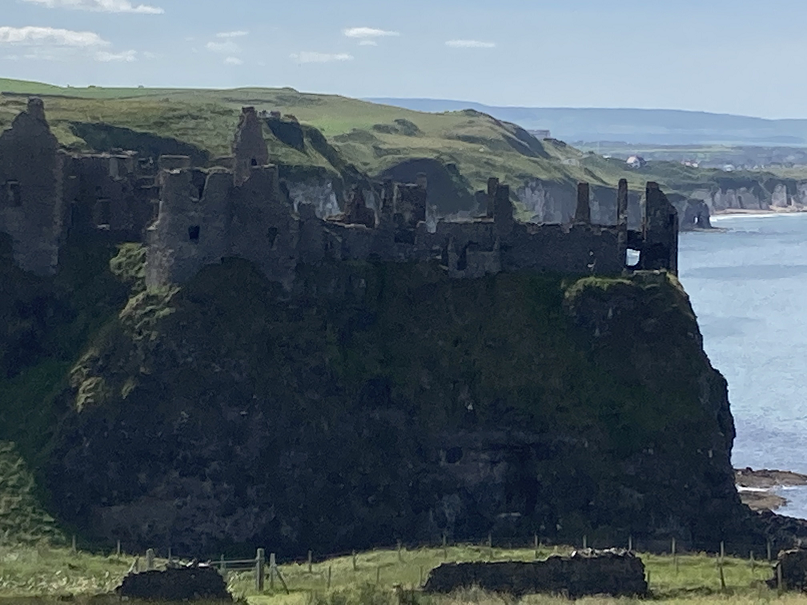
BELFAST
Our next stop is Belfast City Center. Here you will have approximately 60 minutes of free time to enjoy and explore this Northern Ireland’s capital before returning to Dublin for approximately 20:30 pm.
<Traveler> The biggest scam of this trip was the stop in Belfast. As you cruise through the countryside, the driver mentions the “Black Cab” tour of Belfast. What the brochure fails to mention is if you don’t want to pay the extra £20 (Northern Ireland is on the British Pound, but euros are accepted in most cases.) per head, you just get dumped in downtown to shop for an hour or so. The Black Cab tours < https://belfastblackcabtours.co.uk /> picks you up and drives you around the city. On the tour, the driver who is supposed to be a first-hand observer of the Troubles describes the political history of the times of conflict, and shows you various political murals, the Peace Walls (More on this is a separate article), & etc. All told, you are tacking £20 onto the €65per person for the bus ride to get the full experience. Not a price performer. </Traveler>
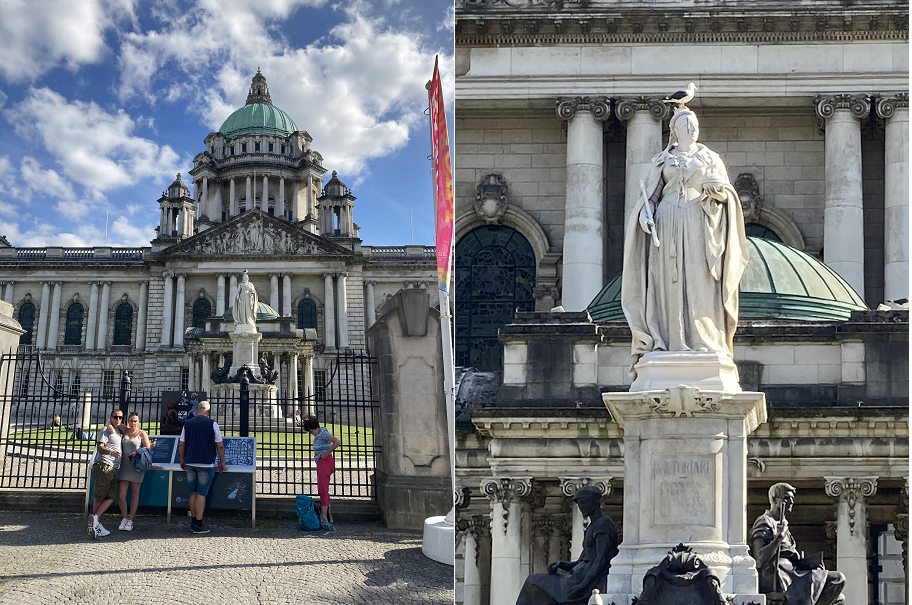
Conclusion
Ireland is for everyone. There is something very romantic looking out the window as you ride along watching the infamous stone walls separating the pastures of the south and west turn into hedges in the north. Ruins of fortified manor houses and ancient homes standing among grazing cattle and sheep make the visitor appreciate the depth of history of the land and her people. The Irish have touched everyone on the planet in one way or another, and they deserve more recognition for their contributions to the richness of humanity. They have been invaded, starved, repressed, exploited, and forcefully relocated for centuries, but they have never been assimilated. They are unashamedly Irish, and Almighty willing, always will be.
Stay safe out there.

Pingback: The Lost Traveler: Spain ~ Wasting Away in Sangria-ville | Hogleg Press